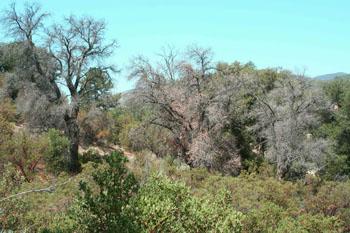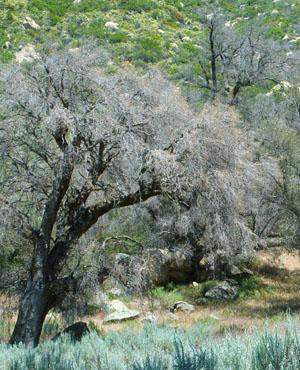Management Options
Researchers are testing several management tactics for goldspotted oak borer (GSOB) in Southern California. The following management options are provided based on current GSOB research findings. With more than a million acres of susceptible oaks in Southern California and millions more acres throughout the state, communities are encouraged to work collectively to develop prevention, monitoring, and response plans before GSOB strikes. Learn more here about guidelines for strategic action before GSOB strikes your community.
Infested Live Trees

Insecticide products most likely to control GSOB are not available to typical consumers and can only be applied by state-licensed and county-registered pesticide applicators (Qualified Applicator License and Qualified Applicator Certificate). Property owners should hire a pest control professional who has experience treating GSOB and other infestations in large oak trees.
For more information, refer to these resources from the University of California Integrated Pest Management program:
Infested Dead and Downed Trees

Find A Licensed or Certified Pest Control Professional
Disclaimer: These tips do not constitute an endorsement or recommendation of any company on the list.
Tools and trade societies to help you find a licensed (QAL) or certified (QAC) pest control professional in your area:
- Search for valid/current licenses and certificates at the CA Department of Pesticide Regulation (search by county or by name of individual/business)
- Contact the CA Association of Pest Control Advisors (CAPCA)
Questions to ask a pest control professional you are considering:
- "Have you ever attended a training on goldspotted oak borer?"
- "What chemical product do you use to control goldspotted oak borer? What is the severity of this infestation, and what treatment method do you recommend?"
Find An Arborist
Disclaimer: These tips do not constitute an endorsement or recommendation of any company on the list.
Tools and trade societies to help you find a licensed arborist in your area:
- "Find An Arborist" Tool (International Society of Arboriculture)
- Member directory for Professional Tree Care Association (San Diego region)
- National Arborists (nationwide)
- American Society of Consulting Arborists (international)
- Check the status of your potential arborist's California contractor license (license type D49, Tree Service Contractor) at CA DCA Contractors' State License Board
Questions to ask an arborist you are considering:
- "Have you ever attended a training on goldspotted oak borer?"
- "What wood management methods do you use to ensure that goldspotted oak borer is not spread?"
Your local telephone directory may also provide listings for arborists and local tree care specialists.
